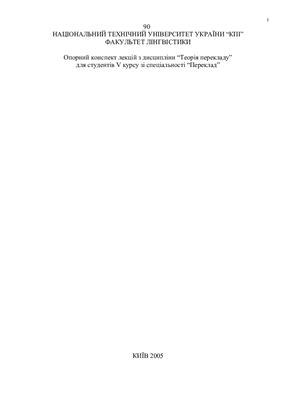НТУУ "КПІ",ФЛ, КТППАМ
Київ - 2005 Загальний обсяг - 56 ст.
Contents
Lecture 1
Model. Perspectives on Translation.
Basic Approaches to Translation and Interpretation.
Main points:
Basic approaches to translation and interpretation.
Translation as intercultural communication.
Lecture 2
Translation as a Human Activity and a Mysterious Phenomenon.
Main points:
Translation as a human activity and a mysterious phenomenon.
Ambiguity problem in translation.
Disambiguation tools.
Lecture 3
Theory, Model, Algorithm - Differences and Common Features.
Main points:
Definitions of theory, model and algorithm.
Language modeling.
Translation as an object of linguistic modeling.
Lecture 4
What is translation theory?
Main points:
The process of translation that creates the product.
Orientation towards different approaches to investigate the process of translation.
Requirements for a theory of translation.
Lecture 5
Human Translation Theories
Main points:
The unit and elements of translation.
Transformational approach.
Denotative approach.
Lecture 6
Human Translation Theories
Main points:
Communicative approach. The notion of thesaurus.
Distributional approach.
Lecture 7
Translating: Modeling the process.
Main points:
The translator: knowledge and skills.
deal bilingual competence.
Expertise.
Communicative competence.
Lecture 8
The process of translation.
Main points:
Stages of the process of translation.
Editing the source text.
nterpretation of the source text.
nterpretation in a new language.
Formulating the translated text.
Editing the translated text.
Lecture 9
Types of Translation
Main points:
Pre-dictionary translation.
Formulation translation.
nstantaneous translation.
Specific skills required for interpreting by ear (at viva voce).
Lecture 10
The Language of Translation
Main points:
The level of lexis.
Sentence level.
Lecture 11
The Language of Translation
Main points:
Discourse level.
The level of variety.
Elaboration on vocabulary exchange as a method of studying the language of translation.
Lecture 12
Meaning. Word-meaning.
Main points:
Reference theory.
Componential analysis.
Meaning postulates.
Lecture 13
The Thesaurus.
Main points:
Lexical and semantic fields.
Denotation and connotation.
Lecture 14
Sentence-meaning.
Main points:
Relations of words and sentences to one another.
Utterance, sentence and propositions.
Lecture 15
Text and Discourse. Types of Context and Contextual Relationships.
Main points:
Text, context and discourse.
Levels of contextual abstraction.
Types of contexts.
Contextual relationships.
Lecture 16
Standards of Textuality.
Main points:
Cohesion and coherence.
ntentionality and acceptibility.
nformativity, relevance and intertextuality.
Lecture 17
Memory. Text Processing (Knowledge).
Main points:
Formal typologies.
Functional typologies.
Text processing (knowledge): syntactic, semantic, pragmatic.
Lecture 18
Text Processing (Skills).
Main points:
nterconnections between text production and text reception.
Problem-solving and text-processing.
Synthesis: writing. Strategies and tactics.
Analysis: reading.
Київ - 2005 Загальний обсяг - 56 ст.
Contents
Lecture 1
Model. Perspectives on Translation.
Basic Approaches to Translation and Interpretation.
Main points:
Basic approaches to translation and interpretation.
Translation as intercultural communication.
Lecture 2
Translation as a Human Activity and a Mysterious Phenomenon.
Main points:
Translation as a human activity and a mysterious phenomenon.
Ambiguity problem in translation.
Disambiguation tools.
Lecture 3
Theory, Model, Algorithm - Differences and Common Features.
Main points:
Definitions of theory, model and algorithm.
Language modeling.
Translation as an object of linguistic modeling.
Lecture 4
What is translation theory?
Main points:
The process of translation that creates the product.
Orientation towards different approaches to investigate the process of translation.
Requirements for a theory of translation.
Lecture 5
Human Translation Theories
Main points:
The unit and elements of translation.
Transformational approach.
Denotative approach.
Lecture 6
Human Translation Theories
Main points:
Communicative approach. The notion of thesaurus.
Distributional approach.
Lecture 7
Translating: Modeling the process.
Main points:
The translator: knowledge and skills.
deal bilingual competence.
Expertise.
Communicative competence.
Lecture 8
The process of translation.
Main points:
Stages of the process of translation.
Editing the source text.
nterpretation of the source text.
nterpretation in a new language.
Formulating the translated text.
Editing the translated text.
Lecture 9
Types of Translation
Main points:
Pre-dictionary translation.
Formulation translation.
nstantaneous translation.
Specific skills required for interpreting by ear (at viva voce).
Lecture 10
The Language of Translation
Main points:
The level of lexis.
Sentence level.
Lecture 11
The Language of Translation
Main points:
Discourse level.
The level of variety.
Elaboration on vocabulary exchange as a method of studying the language of translation.
Lecture 12
Meaning. Word-meaning.
Main points:
Reference theory.
Componential analysis.
Meaning postulates.
Lecture 13
The Thesaurus.
Main points:
Lexical and semantic fields.
Denotation and connotation.
Lecture 14
Sentence-meaning.
Main points:
Relations of words and sentences to one another.
Utterance, sentence and propositions.
Lecture 15
Text and Discourse. Types of Context and Contextual Relationships.
Main points:
Text, context and discourse.
Levels of contextual abstraction.
Types of contexts.
Contextual relationships.
Lecture 16
Standards of Textuality.
Main points:
Cohesion and coherence.
ntentionality and acceptibility.
nformativity, relevance and intertextuality.
Lecture 17
Memory. Text Processing (Knowledge).
Main points:
Formal typologies.
Functional typologies.
Text processing (knowledge): syntactic, semantic, pragmatic.
Lecture 18
Text Processing (Skills).
Main points:
nterconnections between text production and text reception.
Problem-solving and text-processing.
Synthesis: writing. Strategies and tactics.
Analysis: reading.

